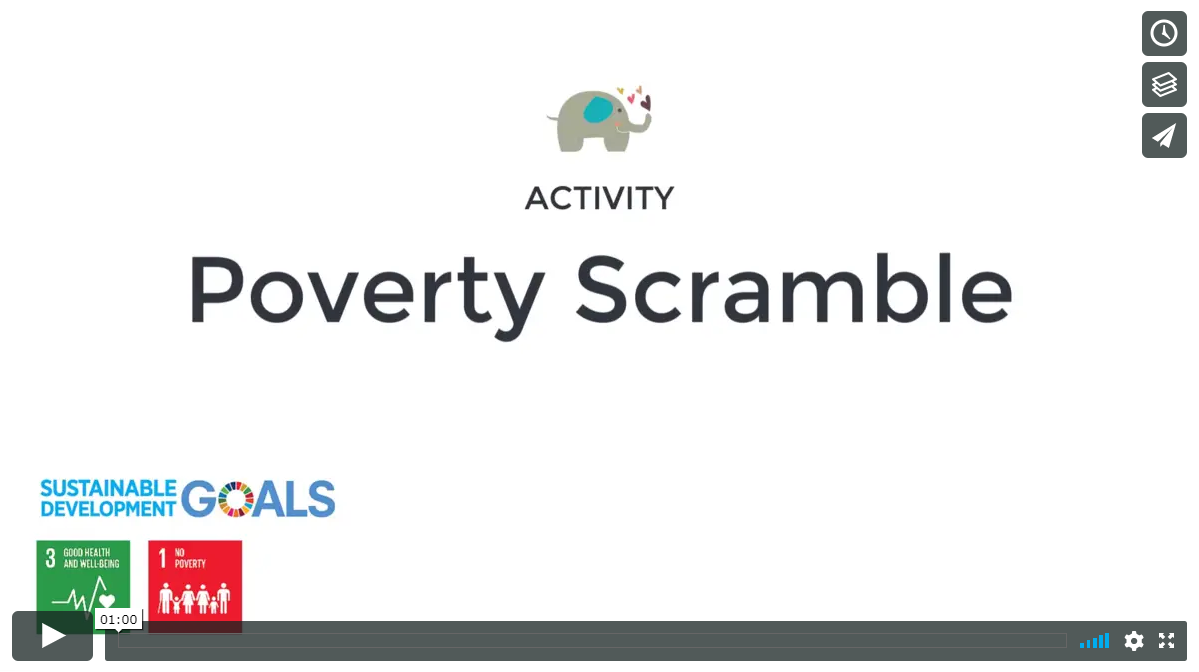Poverty Scramble

Goal
Resources
- Bag of dried beans (any type)
- Plastic spoons
- Drinking straws
- Paper cups
- Activity Instruction Sheet (optional) click to download
Instructions
The Scramble
1. Explain to participants that in this activity they will distribute the wealth and power of the world among themselves. This wealth is represented by the pile of dried beans.
Each child is given a tool to pick up the beans, with 2 spoons, 1 spoon or straw in a set amount of time (suggested 20 seconds). Randomly divide the group approximately so that the majority has straws for example if you have 10 children (6) get straws, (3) get 1 spoon and (1) gets 2 spoons. ) All students must use the tool to pick up the beans using their tools, NOT their fingers. Also, no participant may touch another member of the group at any time.
2. Scatter the beans in the middle of the table. At the order of GO, have participants gather as many beans as possible without touching one another for a set period of time (20 sec).
3. After the timer goes off, have participants count the beans in their cups and report their wealth to the class. Record children’s names and the number of beans on a board or chart paper under three categories:
1) GREAT WEALTH AND POWER (those with most beans – the smallest group);
2) SOME WEALTH AND POWER (those with some beans – the middle group); and
3) LITTLE WEALTH AND POWER (those with the least beans – the largest group).
4. Tell the whole group that these beans represent their wealth and power in the world. The amount they possess will affect their capacity to satisfy their needs (e.g., basic education, adequate food, nutrition, good health care, adequate housing) and wants (e.g. higher education, cars, computers, toys, television, and other luxury items).
Ask participants to move chairs so they are seated with their new group. (If possible– give the GREAT WEALTH AND POWER participants the best seats with lots of room, the SOME WEALTH AND POWER participants less room to sit, and the LITTLE WEALTH AND POWER participants crowded space so they are not very comfortable for the final part of the activity.
Tell participants in GREAT WEALTH AND POWER they will have their basic needs and most of their wants met;
Tell participants in SOME WEALTH AND POWER they will have their basic needs met;
Tell participants in LITTLE WEALTH AND POWER they will have difficulty surviving due to disease, lack of education, malnutrition, and inadequate shelter.
Creating Fairness
5. Explain to the whole group some people in their country (and perhaps in their community) and in every country around the globe lack adequate necessities, such as food, education, health care, and shelter. Point out that others, often in the same community or country, are able to acquire almost everything they need and want.
6. Tell participants that they may, if they wish, give beans to others; however, they are not required to do so. Tell them anyone who shares will be put on a list “PEOPLE WHO SHARE” Allow a few minutes for participants to redistribute the cotton balls if they wish. Ask if anyone changed category (moved up or down) should they change seats as a result of giving or receiving pennies and record these shifts on the chart?
++allow students at this point to sit more comfortably for the debrief section below. You may need to space out the students at the table.
Discussion
- How did you feel at the start about the way in which the beans were acquired and distributed? What group did you end up? Is it just chance where we end up?
- How did it feel to get sorted into a group based on wealth and power?
- Did some people give beans away? Did you give away or receive beans? Why or why not? How did this feel?
- What determines whether or not people gave away beans? Having one’s name displayed? Feeling guilty? Something else?
- How does this game connect to how the world’s wealth and power are distributed?
- After playing this game do you have a better understanding of the situation or attitude of developing people/nations? Of the situation or attitude of wealthy people/nations?
- We are celebrating UNICEF’s WDC theme #kidstakeover. How would you redistribute wealth and power throughout the world? How would you propose to accomplish this? What principles would guide your proposals for change?
Activity Source

About this activity…
AGE:
SDG:
GROUP SIZE:
EQ AREA:
TIME:
DEMO VIDEO:


0 Comments